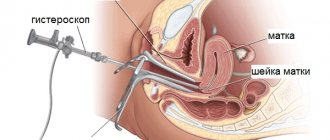Complaints about menstrual irregularities are among the three most common reasons for which women consult a gynecologist. Patients in this pathological group include:
- shortening or lengthening the interval between menstruation;
- scarcity of blood secreted or, on the contrary, abundance;
- soreness;
- short duration (less than 3 days) or, on the contrary, prolonged bleeding (more than 7 days);
- Irregularity of the cycle, accompanied by both long delays and frequent bleeding.
Discharge after menstruation is also considered a woman's cycle disorder. Although this symptom may have a whole group of causes that differ in the mechanism of occurrence.
Hormonal disbalance
Deviations in the functioning of the thyroid gland can lead to hormonal imbalance throughout a woman’s body. In medicine, this phenomenon is called hypothyroidism in women. This manifestation can provoke an increase in the amount of blood, and sudden weight fluctuations may begin. Also, hormonal imbalance can lead to polycystic ovary syndrome or increase the period of discharge, and menstruation may be delayed by spotting. Hypothyroidism in women can also cause spotting in the middle of the cycle.
The importance of maintaining high-quality intimate hygiene during lingering discharge
Stretching vaginal discharge should not cause significant discomfort. But mucus often stains laundry. In addition, sticky vaginal discharge is a breeding ground for many bacteria and fungi. To prevent the development of infectious and inflammatory diseases, it is necessary to monitor the quality of personal hygiene, wash regularly and use special protective equipment. This will allow you to maintain maximum comfort in the intimate area throughout the day. When choosing personal hygiene products, give preference to products with natural and safe compositions that do not irritate the skin and support healthy vaginal microflora.
Carefree® panty liners help solve the problem of non-menstrual discharge, which can be quite heavy, especially in the middle of a woman's cycle. The delicate surface immediately absorbs mucus, allowing you to feel comfortable.
Emergency contraception
Such a deviation from the norm may occur when taking emergency contraception. Those women who had to resort to this method of protection claim that they encountered side effects such as brown discharge after menstruation, an unpleasant odor and pain. All this is an integral attribute of some contraceptives. Other bleeding may also occur after taking Escapel or Postinor. If you take Postinor during menstruation, then at the end of the menstrual cycle the woman will notice uncharacteristic discharge for several days.
What to do about clots during menstruation
If you suspect that the discharge is pathological, you should visit a gynecologist. Only he will be able to determine whether clots are normal or pathological in each individual case.
You may need to be examined by an oncologist or endocrinologist. If the blood loss is too severe and the lumps are large, you need to call an ambulance; hospitalization may be necessary.
Sometimes bleeding can only be eliminated by removing the endometrium. Therefore, self-medication in such cases is unacceptable.
Let's look at how to stop bleeding before the doctor arrives:
- Etamzilate is a first aid drug; it is able to stop bleeding without clotting the blood. Etamsylate does not contribute to the formation of blood clots, and begins to act after half an hour. The effect of taking it lasts for 5 hours.
- Dicinone - stops heavy bleeding and is used for heavy menstruation. It is recommended to use only after consulting a doctor, as the drug has side effects.
- Water pepper tincture – helps speed up blood clotting, eliminates inflammation and stops heavy bleeding.
Conclusion
For the prevention and strengthening of blood vessels, it is recommended to take Ascorutin. Contraindications for use are thrombosis and genitourinary diseases.
In order to prevent heavy periods with clots, it is necessary to regularly, once every six months, be examined by a gynecologist, and have an ultrasound of the pelvic organs once a year.
Intrauterine device
Installation of an intrauterine device or ring can also lead to changes in how the body functions. These types of contraception function as an irritant to the vaginal mucosa. In this case, the woman needs to pay attention to the fact that if pink discharge after menstruation does not stop after a week, this indicates that the blood vessels in the vagina have been injured. In this case, experts recommend immediately going to the specialist who installed this device. Unfortunately, even a couple of small wounds inside the vaginal mucosa can lead to deterioration in health. Intermenstrual bleeding and uncharacteristic clots appear, which in the future can lead to bleeding altogether.
If a woman begins to use broad-spectrum drugs and she develops a red discharge, this is due to the fact that the drug that began to enter the body has a high level of effect on blood clotting.
Natural Causes of Menstrual Clots
Normally, menstrual smears are dark red in color and have a mucus-like structure. Often, lumps of blood or epithelium can be observed in the discharge.
If there are few lumps, your periods are not particularly painful, last no longer than 6 days, and if no more than 100 ml of blood is released, then there is no need to panic.
Let's look at why lumps form in a normal situation:
- Prolonged sitting or lying down. Without movement, the blood begins to accumulate and thicken, and when you change position, it immediately flows out in the form of thick lumps.
- Adhesions or scars of the uterus provoke the appearance of lumps. This occurs due to a violation of the outflow of blood and mucus in the organ cavity.
- Congenital abnormalities in the shape or location of the uterus lead to thick discharge.
- High viscosity due to kidney pathologies, liver diseases, and low fluid intake.
Other causes of clots
- In addition, blood with clots may appear while taking coagulants and hormonal drugs. These drugs increase blood clotting, which leads to the formation of blood clots.
- The contraceptive device can also affect the occurrence of menstrual lumps.
- Accumulations of blood may appear in the first time after an abortion, as particles of the fertilized egg are released from the uterus. During abortion and childbirth, severe hormonal disruption occurs, which causes heavy menstruation.
- Changes in hormonal levels at different age stages in a woman directly affect menstruation. The formation of lumps indicates changes in the mucous membrane.
- The presence of bad habits, irregular nutrition - all this affects changes in menstrual flow. Alcoholic drinks affect blood viscosity, after which large blood clots are visible in the discharge.
Injuries
Trauma to the genitals can also lead to discharge. If a woman had to endure acts of a violent nature or sexual intercourse was prolonged without additional lubrication and at a time when natural lubrication had already dried up, bleeding may appear. Also, this phenomenon may be accompanied by severe pain in the lower abdomen, in which case it is necessary to contact a specialist immediately. The doctor will have to conduct an examination and, if necessary, take biomaterial and scrapings for analysis in order to reject possible causes of the ailment.
External factors
Also, a malfunction may occur in the female body due to exposure to external factors. For example, excessive stress on the psycho-emotional level or physical stress can provoke bleeding even after the end of menstruation. This phenomenon can be extremely unpleasant even after the initial causes have been eliminated. You should not let the situation take its course; additional medical intervention is necessary. Many women who have experienced severe stress that provoked bleeding state that if they did not consult a doctor the first time after a nervous shock, then after the situation repeated, the discharge became more profuse. In this case, patients need to see a doctor who will prescribe a course of sedatives in order to combat such a deviation. The reasons are extremely simple and it is enough to limit yourself to taking mild sedatives. They are combined with various herbal infusions.
Infections
Infections can also cause bloody discharge. Sexually transmitted diseases are very dangerous. After all, they begin to intensively affect the human body, and this can lead to various pathological processes. If such a situation occurs, in no case should you leave things to chance or engage in treatment yourself; you should immediately go to a gynecologist for a consultation. The specialist will conduct a diagnosis and prescribe a set of medications that are aimed at eliminating the infection.
Nettle decoction to stop menstruation for 1-3 hours
Nettle decoction is one of the most harmless ways to stop menstruation at home for a few hours, because it does not harm the body’s hormonal levels and does not affect the menstrual cycle. The effect lasts up to 12 hours.
Many women are interested in how to stop menstruation at home. A decoction of nettles is suitable for this purpose.
Nettle has hemostatic properties, normalizes the monthly cycle, prevents ectopic pregnancy, and expands the lumen of the fallopian tubes. Drink the decoction as tea for 2 days. Method of preparation (per day): add 40 g of dried nettle leaves to 600 ml of boiling water, heat in a water bath and boil for 5 minutes. This volume is enough for 5-6 doses every 2 hours.
The decoction is contraindicated for:
- kidney and liver diseases;
- pregnancy:
- malignant tumors;
- cardiovascular diseases (thrombosis, thrombophlebitis).
Treatment of bleeding after menstruation
Therapy associated with red discharge that appears after menstruation depends on the reason why this condition occurred. If the gynecologist has determined the cause of the disease is associated with an infection, the patient is prescribed local antibiotics, as well as drugs that improve the functioning of the immune system. The duration of such treatment takes on average 4-5 weeks. It is also worth understanding the fact that in the case of an infectious disease, not one, but both sexual partners must undergo therapy.
In some cases, discharge depends on how many days there are between periods in a woman’s cycle. If it is not regular, then hormonal treatment is necessary. To normalize the cycle, contraceptives “Jess” are used. These are tablets that contain substances such as ethinyl estradiol and drospirenone. After regular use of the pills on the recommendation of a specialist, the problem with discharge will disappear. However, the medication cannot be used for diabetes, thrombosis, renal failure, pancreatitis and other serious diseases.
If endometriosis or uterine papilloma has been diagnosed, then surgical intervention is necessary. Unfortunately, therapy will not help solve all disorders in the endocrine system. In this case, hormonal drugs are also prescribed, but they are purely individual and are recommended for women depending on the results of the analysis.
If a doctor has diagnosed uterine cancer, then a consultation with an oncologist is necessary, who will prescribe the therapy. If uterine cancer is diagnosed and bleeding develops, the woman is prescribed a hemostatic agent and is also recommended for restorative treatment. The patient will also need to pay attention to her diet. The menu should include legumes, beef, fruits, vegetables and liver. This will allow the body to restore losses as quickly as possible.
As soon as deviations from the norm appear in the body, strange discharge appears and the woman’s condition worsens, it is necessary to immediately go to a specialist in order to exclude the development of serious pathologies. The doctor will conduct the necessary examination, determine the diagnosis, according to which he will prescribe treatment. As soon as even minor deviations in the menstrual cycle appear, you need to go to a gynecologist for a consultation. He will help to identify the pathology in a timely manner and prescribe treatment, for example, “Jess” contraceptives, which will help normalize the cycle and improve the patient’s condition.
Pathological causes
The appearance of thick mucous impurities is associated with impaired growth of the endometrium in the uterus, as well as changes in the blood vessels and tissues of the organ. Below we will look at the serious causes of pathological periods with photos.
- Endometriosis is a thickening of the endometrial layer inside the uterus, its penetration into the ovaries and tubes, into the cervix and peritoneum. During this disease, the entire cycle is disrupted, smears become abundant, inconsistent and with clots.
- Uterine fibroids are a benign tumor that arises in the muscle tissue of the uterus and grows along its lining. When fibroids spread to the entire organ cavity, disturbances in the cycle appear. This happens due to pressure on the vessels and their damage. Myoma can block the exit from the uterus to the cervix, which can trigger the development of blood clots. Fibroids are characterized by strong smears with blood lumps, an increase in the size of the abdomen and pulling cramps in the abdomen.
- Polyps in the uterus and cervix are growths on the inner wall of the organ. During the passage of the endometrium from the uterine cavity, polyps can be injured. Parts of these tumors are excreted along with the blood, forming clots.
- Endometrial hyperplasia - develops against the background of damaged endometrium, resulting in hormonal imbalance or curettage during an abortion. The consequence of this is a disruption of the structure of the endometrium, thickening and detachment of its mucous membrane. Due to the destruction of blood vessels, bleeding increases.
- Cervical erosion - when damage to the vaginal mucosa occurs, cracks and ulcers form, which provokes erosion. The reason for this is diagnostic curettage, childbirth and abortion. Bacteria enter microcracks and cause inflammation. This provokes cycle disruption and the appearance of clots.
- Infections of the genital organs contribute to the appearance of inflammation in the organ cavity, which entails a change in its structure. In addition, microbes secrete specific substances that change blood viscosity. This leads to the appearance of thick lumps.
Possible causes of clots include problems such as metabolic disorders, thyroid disorders, and diabetes.
The development of a malignant tumor is also possible, so if pathology appears, it is important to immediately consult a doctor.










